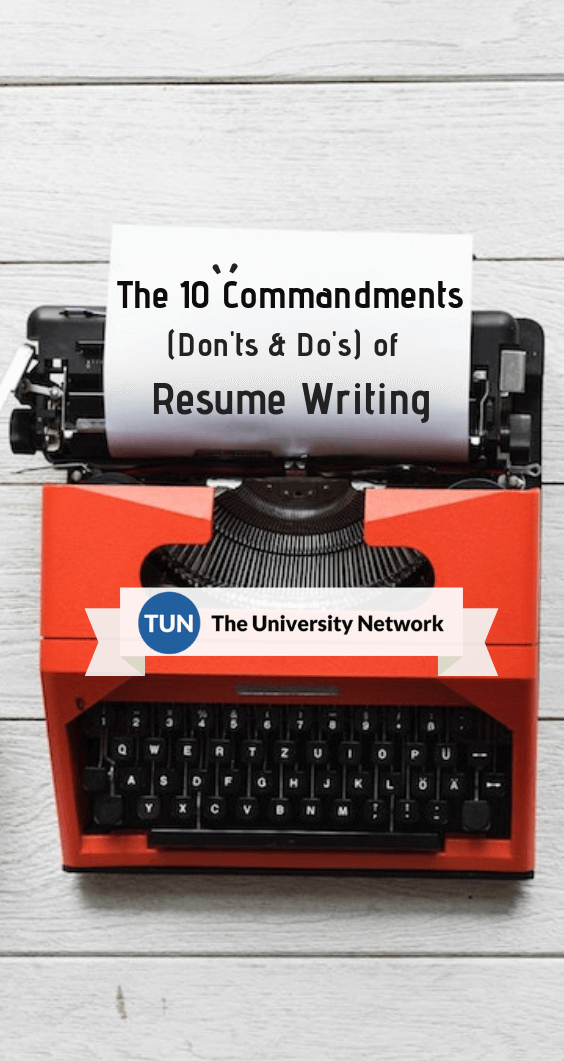Are you looking to polish up your resume for a new job but aren’t sure how?
Well, you’ve come to the right place: this article will tell you the DOs and DON’Ts when it comes to writing your resume.
But first, KNOW THIS: your resume does NOT define WHO you are or WHAT you’re worth. I mean, really, all it is is a piece of paper that the recruiters spend less than 10 seconds looking at!
However, you and I both know all too well that it is essentially this piece of paper that gets you the call back — or not. And that’s why here I offer you tips on how to maximize your chance of getting noticed. Making a good first impression is the first step!

SEE ALSO: 5 Pro Tips to Getting Your Scholarship Entry NOTICED
[divider]
♦THOU SHALT NOT♦
1. Have irrelevant part-time jobs from high school listed.
Think about it: does your SAT score or AP scores really matter once you’re in college? No.
Similarly, recruiters aren’t interested in how many jobs you had in high school; they only want to know what transferable skills you have.
2. Have spelling errors, typos or incorrect grammar, especially if the position you are applying for requires attentiveness to detail (or you wrote somewhere on your resume or cover letter that you are “detail-oriented“).
Check you didn’t mix up “possess” and “posses,” “madame” and “madam,” “manager” and “manger,” etc. as auto-correct will not correct them! Typos and spelling errors are apparently the #1 pet peeve of hiring managers.
→ To avoid making these silly (yet all too common mistakes) you can try the following:
- Have someone else — who is a stickler for grammar — read over your resume.
- Read it out loud/from the bottom-up.
- Print out a physical copy and then proofread it.
- Allow some time before you pick it up again to proofread it one last time.
3. Use third-person — you should avoid using the word “I” (because it’s already assumed that the subject is YOU) but you should all the more avoid using third person. If those experiences are YOUR experiences, why make them sound like they are someone else’s?
4. Use silly or unprofessional email addresses — that’s just… unprofessional.
5. Write a long objective — ultimately, from the company’s perspective, your objective is to get a job. Besides, the recruiters on average spend 3 seconds looking at your resume, so it’s likely that they’re not even going to read your objective statement. Just get to the meat of it.
[divider]
♦THOU SHALL♦
6. OPTIMIZE! Use keywords from the job posting so that your resume makes it past the automated screening (which is often the case with a lot of companies nowadays).
7. Tailor your resume to the specific position you are applying for — don’t give the impression that you’re sending out this same resume to 20 other companies.
8. Show personality (especially if you’re applying for a creative position). You are allowed to be creative (just don’t overdo it). After all, you want your resume to stand out, don’t you? One suggestion is to make your name POP out– you can play around with the font, size, and color to make your name stand out from the page.
9. Put your phone number, even if email is your preferred method of contact (and make sure you have a professional voicemail message set up). If the company is looking to hire immediately, they might call you instead of emailing you. If you don’t pick up or return the call, it’s your loss.
10. Remember that space is limited. You cannot possibly tell your whole life story on a single piece of paper. That’s why you highlight the important parts and save the more in-depth explanations for the interview. Your job at this point is to get them curious!
[divider]
Now, as for the formatting, here are some [sections] you might want to include in your resume:
- Personal information (including education)
- Work Experiences (jobs + internships)
- Volunteer Work & extracurricular activities
- Leadership Positions
- Skills + Accomplishments
- Personal Projects or Portfolios (links to published blogs & articles, artwork, etc.)
- References (upon request)
And finally, feel free to get creative with your resume if you are applying for a creative position! That’s probably your first test!
[divider]
Once you’ve made past the screening process and are invited for an interview, go show ’em who you are and what you’re all about ;).



